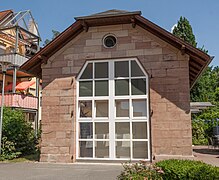Feucht – Wendelstein railway line
| Feucht – Wendelstein | |||||||||||||||||||||||||||||||||||||
|---|---|---|---|---|---|---|---|---|---|---|---|---|---|---|---|---|---|---|---|---|---|---|---|---|---|---|---|---|---|---|---|---|---|---|---|---|---|
| Course book section (DB) : | 420f | ||||||||||||||||||||||||||||||||||||
| Route length: | 5.3 km | ||||||||||||||||||||||||||||||||||||
| Gauge : | 1435 mm ( standard gauge ) | ||||||||||||||||||||||||||||||||||||
|
|||||||||||||||||||||||||||||||||||||
The Feucht – Wendelstein line was a branch line in Bavaria . It branched off the Nuremberg – Regensburg railway line in Feucht and led to Wendelstein in Middle Franconia . The route was popularly known as the Schwarzach Express . When it opened, it was the shortest local railway in Bavaria.
history
After many years of planning the route and its inclusion in the Local Railway Act of 1884, construction work began in 1885. On August 1, 1886, the local railway went into operation.
In addition to people, mainly stones from the nearby quarries of Wernloch , beer, construction and firewood from local production for export, as well as metals, fertilizers and above all imported coal were transported.
Around 1900 the one-way fare was thirty pfennigs and the journey time was twenty minutes.
During the Second World War , a double-track connection led to the war-important MUNA Feucht and, temporarily, another connection to the secretly planned but unrealized MAN tank factory in the southern Reichswald between Röthenbach and Nerreth .
There the connection to the so-called broad - gauge railway should have been made, which, however, never got beyond the project and planning phase, test and model constructions and some site explorations. This junction and a bridge over the Schwarzach were never in operation and were abandoned and dismantled before the end of the war.
In 1950 the fare was one D-Mark for a single trip to Nuremberg and 1.20 D-Mark for a return trip. With seven pairs of trains a day, the train offer was quite high for the conditions at the time. Shortly before the shutdown, ten pairs of trains ran on weekdays. The travel time to and from Nuremberg took about fifty minutes with transfer or shunting times in Feucht.
For those interested in culture there were so-called theater trips . This was a train that did not leave Nuremberg until 11:54 p.m. Passenger traffic was discontinued on May 22, 1955.
On July 7, 1957, the route experienced a surprising revival in passenger transport and a diverse response from the population when Chancellor Adenauer stopped there with his own saloon and transport car and stayed overnight. The Chancellor's limousine Mercedes-Benz Pullman was also carried. On September 11, 1957, Adenauer used the station again on the occasion of the political events in Nuremberg. This was not perceived as particularly spectacular on site.
Freight traffic was given up on February 1, 1960. After massive protests and a petition, there were isolated post-operations until autumn 1961, before the line was finally shut down and then dismantled. In the 1970s, the former locomotive shed in Wendelstein was still used as a meeting place for young people.
The route today
A remnant about 200 meters long forms a pull-out track at Feucht station. In the further course it is completely overgrown (as of 2018) and is interrupted by the high-speed route Nuremberg – Ingolstadt – Munich . Plans to reconnect the Nuremberg-Feucht business park to the rail network were rejected because of the high costs that could be expected from a crossing. The route then exists as a forest path that crosses under the federal highway 73 and leads to the junction of the St 2239 to Röthenbach. Then it is completely built over by the road up to the Ludwig-Danube-Main Canal. The remaining 400 meters lead as a gravel path parallel to the canal to the former landing stage of the canal to Wendelstein. In Wendelstein, in addition to the street name “Am alten Bahnhof”, the restored station building and the engine shed are a reminder of the abandoned line. The station building, erected around 1890 in a country house style, and the locomotive shed are listed as a monument (D-5-76-151-2). Today (2018) both buildings are part of a refuge for elderly-friendly living. A noise protection wall specially built in the 1990s prevents a view of the former railway and port area from the state road.
Route description
The line branched off the main line from Nuremberg to Regensburg west of Feucht station and ran from there in a south-westerly direction parallel to the course of the Gauchsbach and Schwarzach valleys along the now-abandoned Ludwig Canal to the Wendelstein terminus, 5.3 kilometers away . Most of the route led through the community-free area of Forst Kleinschwarzenlohe .
Picture gallery
The former route near the Jägersee
literature
- Ulrich Rockelmann: Searching for traces of dismantled railway lines in the Nuremberg area . Hofmann Verlag, Nuremberg 1999, ISBN 3-87191-270-0 .
Web links
- Location and course of the route on the OpenRailwayMap
- Course of the former railway line in OpenStreetMap
- several dozen photos of the remaining route remains on a private website
- Course book from 1944





